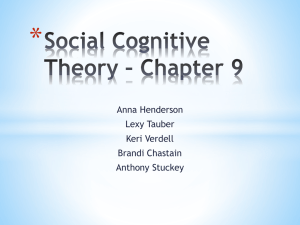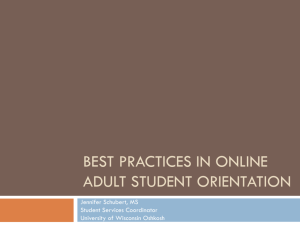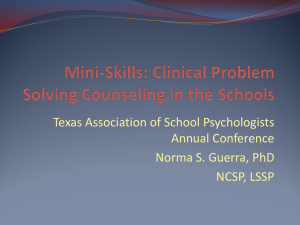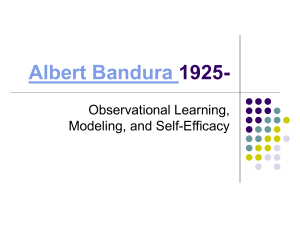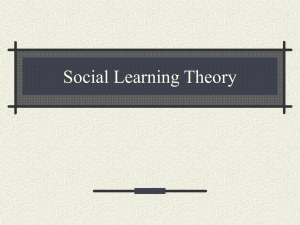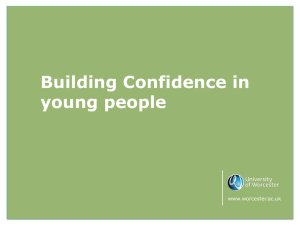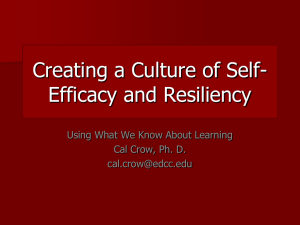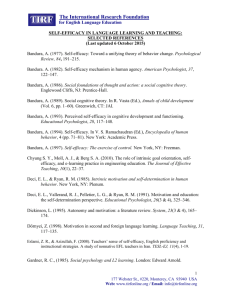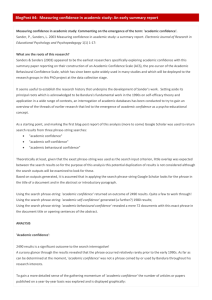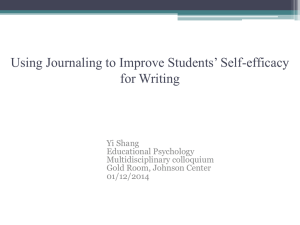Social_Learning_Theory
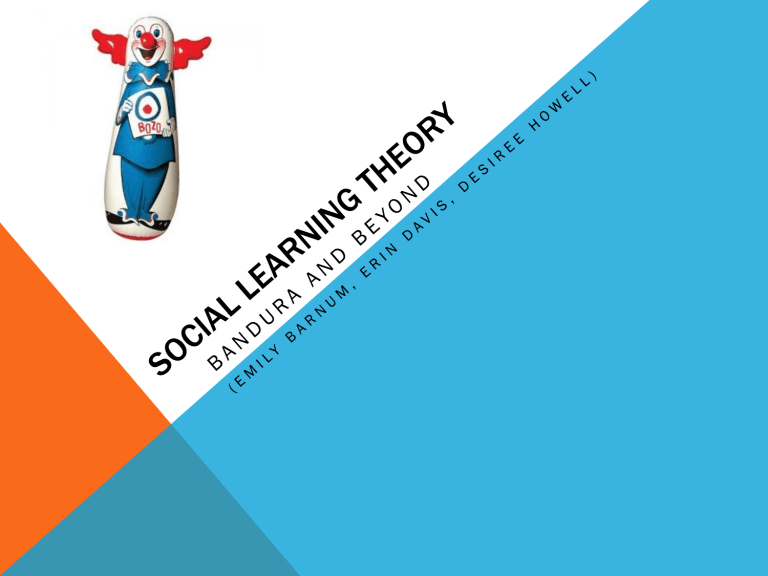
IN A NUTSHELL
Social Learning Theory is an explanation of learning and development that examines an individuals development according to his /her learning from social models or cues (can be a person or a medium).
• Has cognitive, behavior and social components (children learn through internal, external and environmental means)
• The methodology used was strict, well-developed and controlled laboratory experiments (ex. Bobo doll)
• Bandura has moved from a strict social learning approach to a highly cognitive learning approach, stressing that the influence of individual to social environment goes both ways.
• In recent years, Bandura has emphasized self-efficacy, or “people’s perception of their competence in dealing with their environment” (188).
• Modern social learning theory includes interaction between the psychology of the person (P), the person’s behavior (B), and the environment (E). They are highly interdependent. Bandura calls this process triadic reciprocal causation.
COMPONENTS OF LEARNING THEORY
TRIADIC RECIPROCAL CAUSATION
THE SIMPLE VERSION (HUMAN DEVELOPMENT)
What’s going on cognitively?
When the child observes the model,
(s)he has ideas, personality, and thoughts about the symbol.
What behavior is reinforced?
Will there be rewards or benefits through imitation? Punishment?
Social or personal needs met?
Who are the social models?
Who is the child watching, believing, noticing: parents, peers, media?
CHILDREN WILL IMITATE ROLE MODELS’ BEHAVIOR
One of the main ideas in social learning theory is that behavior is learned through imitation, and through positive reinforcement of that behavior.
In the media we have seen ‘funny’ (see right) and ‘not so funny’ (next slide) depictions of this modeling process.
As you watch the video, contemplate this question; will children always imitate what they see from parents? Why do some children follow their parents’ example, and others do not?
What would Bandura have to say about this?
CHILDREN SEE, CHILDREN DO (AUSTRALIA)
http://youtu.be/JWS5yN0VNBk
ALBERT BANDURA BOBO DOLL (AGGRESSION)
POSITIVE? SOCIAL LEARNING
STRENGTHS/WEAKNESSES (CRITICISMS)
STRENGTHS of social learning theory:
Focus on the situational, social, and emotional influences on behavior
Testability
WEAKNESSES of social learning theory:
Inadequate account of cognitive development
How is a child’s thinking organized, and how does this change during development?
How does modeling/imitation change during different ages? Infants?
Inadequate description of development in natural settings
How does change happen outside of the lab setting?
Lack of diversity in early studies; cultural research? (Hart & Kristonis, 2006)
Why do parental and media influence differ so vastly? (Berry, 2003)
WHO ARE THESE CHILDREN IMITATING?
Talking Twin Babies
WHAT IS GOING ON COGNITIVELY FOR THEM?
HOW ARE THEY INTERACTING WITH THEIR ENVIRONMENT?
Cognitive Translation
New York
SELF-EFFICACY
• Belief that you are capable of learning and/or performing specific tasks
• Self confidence = self-esteem + self-efficacy
• It is a mediating aspect of the ‘Person” component of the triadic reciprocity model (person/behavior/environment)
Porter, L. (2008). Young children’s behaviour: Practical approaches for caregivers and teachers. Australia: MacLennan and Petty, Ltd.
•
•
•
•
•
SELF-EFFICACY AFFECTS…
Choice of activities
Effort
Persistence
Learning
Achievement
•
Wellbeing
•
Self-efficacy is domain specific
• Career decision-making
• Parenting
• Counseling
• Math ability
DEVELOPMENT OF SELF-EFFICACY
• Previous learning experiences
• Opportunities for practice
• Consequences
• Observations of other people
• Modeling
• Messages from other people
• Reinforcement or Punishment
• Persuasion
GROUP DIFFERENCES IN POWER & STATUS
• Self-efficacy is useful when examining group differences in power and status
• “When group members are denied access to opportunities and experiences , they are less likely to gain the confidence and skill needed to succeed in those areas” (p. 140).
• Need for greater access to resources for all
• Role models
Miller, P.H., & Scholnick, E.K. (2000). Toward a feminist developmental psychology .
New York: Routledge.
LOW SELF-EFFICACY & PREJUDICE
• Higher risk of low self-efficacy in areas where prejudice and discrimination exist
• Eccles’s 1989 longitudinal study on gender differences in math achievement
• Implications for college, achievement, careers, SES, wellbeing
• Identity development and self-esteem
• Similar to Stereotype Threat
MORALITY
• Doesn’t account for emotions such as shame/guilt.
• Social Learning theory states that development is a process and does not occur in distinct stages.
• This means that morality can be learned at any point during development/life and is depended on the modeling effects of circumstance and reinforcement.
DRINKING AND STALKING HABITS IN COLLEGE
AGE STUDENTS
DRINKING TRADITIONS AMONG COLLEGE
STUDENTS
http://www.youtube.com/watch?v=U1_OdrZlQgM
DRINKING NORMS IN ADOLESCENTS
The average age of beginning to drink is at the age of 11
Relationship between modeling of alcohol use by others and adolescent alcohol misuse were always moderated by the nature of social bonds.
Family social regulation buffers the effects of adolescent alcohol misuse
Social regulation amplifies the modeling effects of alcohol misuse
Ennett, S. T., Faris, R., Foshee, V. A., Bauman, K. E., Hussong, A., Cai, L.,
Reyes, H. L. M., Hipp, J., & DuRant, R. (2008). The social ecology of adolescent alcohol misuse. Child Development,
79( 6 ), 1777-1791.
DRINKING NORMS IN COLLEGE
• Permissive perceived alcohol norms, related to higher levels of alcohol usage.
• Episodic drinking is mediated through learning/social norms
• Binge drinking is often put in a positive light on college campuses and many corporations pray on that.
• http://www.youtube.com/watch?v=FIT3WlIyy1Y&feature=fvwrel
Durkin, K. F., Blackston, A., Dowd, S., Franz, S., & Eagle, T. (2009). The comparative impacts of risk and protective factors on alcoholrelated problems in a sample of university students. Journal of Offender Rehabilitation. 48, 696-709. doi:
10.1080/10509670903287766
Ward, B. W., & Gryczynski, J. (2008). Social learning theory and the effects of living arrangements on heavy alcohol use: Results from a national study of college students. Journal of Studies on Alcohol and Drugs. May 2009, 364-272.
PREVENTION/IMPLICATIONS
• Friends reinforce drinking motives the most, and prevention/intervention procedures are most effective when coming from friends.
• Traumatization at a young age can lead children to continue the cycle when they grow older
• Trauma
• Abuse
• Alcoholism
• Family Violence
• Rape
Abbassi, A., & Aslinia, S. D. (2010). Family violence, trauma and social learning theory. Journal of Professional
Counseling: Practice, Theory and Research 38( 1 ),16-27.
STALKING
• Stalking behaviors are often learned, modified and reinforced through interactions with peers.
• Rationalize or neutralize deviant behaviors – even when friends are victims
• Victims have similar reactions – and sometimes view stalking as positive.
• Possession of sexually deviant behavior and attitudes learn to become motivated to act on these behaviors
• Sexually violent deviant behavior from parents
• Friends who are sexually violent
• Direct behavioral imitation
Fox, K. A., Nobles, M. R., & Akers, R. L. (2011). Is stalking a learned phenomenon? An empirical test of social learning theory.
Journal of
Criminal Justice, 39(1), 39-47. doi: 10.1016/j.jcrimjus.2010.10.002
Chan, H. C., Heide, K. M., & Beauregard, E. (2010). What propels sexual murderers: A proposed integrated theory of social learning and routine activities theories. International Journal of Offender Therapy and Comparative Criminology, 55(2), 228-250. doi:
10.1177/0306624x10361317
